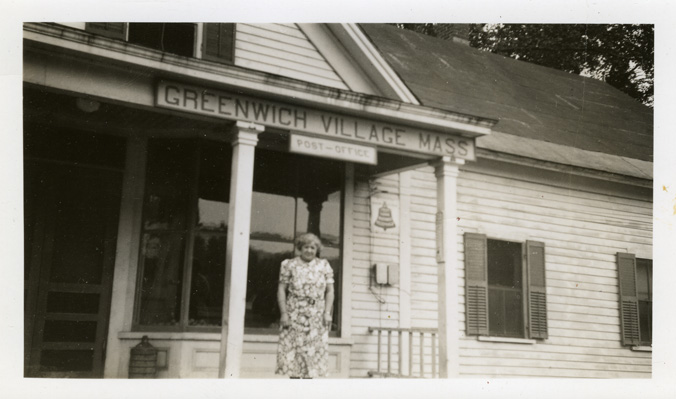Background on Greenwich, Mass.

Dorothy P. King, postmaster, Greenwich Village, ca.1935
First granted in 1737 to descendants of the veterans of King Philip's (Metacomet's) War, and incorporated as Quabbin Parish in 1754, the town of Greenwich sat astride the East and Middle branches of the Swift River and formed the eastern boundary of Hampshire County. The first town to occupy the valley, its unforgiving and rocky soils were devoted largely to agricultural use and pasturage, with light industry developing during the nineteenth century. A woolen mill; scythe, rake, fork, and broom manufactories; at least two saw mills; a match factory; and a plating operation employed a handful of workers each. Ice harvesting and a small cottage industry centered on the manufacture of palm-leaf hats providing additional employment. Before the turn of the twentieth century, the rise of a tourist industry exploiting the town's numerous ponds and lakes became an important element of the local economy, with the Quabbin Inn, Greenwich Hotel, and Dugmar Golf Course becoming popular summer destinations.
Well connected to neighboring towns by two turnpikes and the "Rabbit Run" Railroad, the two principal villages (Greenwich Plains and Greenwich Village) supported a population of nearly 1,100 before declining slowly after about 1850. Like the other towns in the Swift River Valley (Dana, Enfield, and Prescott), Greenwich's fortunes dimmed considerably after the 1890s. Confronted with a critical demand for water in the Boston metropolitan region in 1895, the Commonwealth authorized the new Metropolitan Water District to seek new supplies in the western parts of the state. Construction of the Wachusett Reservoir along the Nashua River (1897-1908) bought time, but ultimately failed to meet projected demand, and by 1922, the MWD officially signaled its intention of damming the Swift River Valley, signifying an end to habitation there. All residents were ordered removed from the valley, with homes, farms, and places of business systematically destroyed, the land cleared, and graves removed.
Work on the Quabbin Reservoir began four years later with construction of the Ware River Diversion, a tunnel connecting the Wachusett Reservoir with the Ware River, followed in 1936 by construction of the Goodnough Dike and Windsor Dam. Greenwich was officially disincorporated by the state on April 28, 1938, with the above-water portions annexed to nearby Hardwick, New Salem, Petersham, and Ware. On Aug. 14, 1939, the reservoir began to fill.

